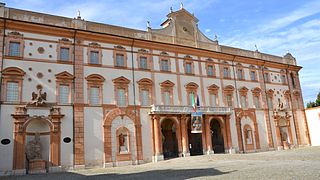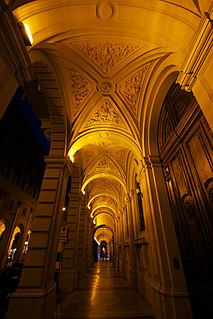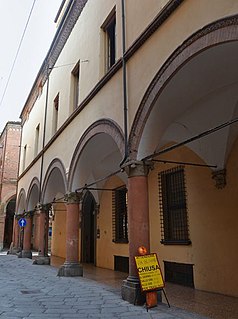

The Palazzo Vivarelli Colonna is a palace located at via Ghibellina #30, corner with angolo via delle Conce, in central Florence in the region of Tuscany, Italy.


The Palazzo Vivarelli Colonna is a palace located at via Ghibellina #30, corner with angolo via delle Conce, in central Florence in the region of Tuscany, Italy.
The palace has had multiple owners over the centuries. In the 16th century, the Granacci combined a number of structures at the locale into one palace and garden. From the 16th to the 18th century it was owned by the Gaburri including by the art patron Francesco Maria Niccolò Gabburri, before being inherited by the Lotteringhi della Stufa family. In the 19th century, it was owned by the banker Michele Giuntini, who commissioned a cycle of frescoes here. From 1857 to 1979 it was owned by the Vivarelli Colonna. [1]
The palace once had frescoes by Antonio Domenico Gabbiani, Pier Dandini, Alessandro Gherardini, and Giovanni Camillo Sagrestani, commissioned by Gaburri. Now the 19th century frescoes displayed in the first floor were completed by Angiolo Angiolini, Luigi Catani, Gasparo Martellini, Giuseppe Collignon, Francesco Nenci, and Giuseppe Bezzuoli.
The palace has a small formal Italian-style garden adorned with an 18th-century wall fountain and grotto installed by Gabburri depicting Orpheus and his lyre. The garden was restored just before the year 2000. The building is now owned by the City of Florence. [2]

Ca' Rezzonico is a palazzo on the Grand Canal in the Dorsoduro sestiere of Venice, Italy. It is a particularly notable example of the 18th century Venetian baroque and rococo architecture and interior decoration, and displays paintings by the leading Venetian painters of the period, including Francesco Guardi and Giambattista Tiepolo. It is a public museum dedicated to 18th-century Venice and one of the 11 venues managed by the Fondazione Musei Civici di Venezia.

The Palazzo Pitti, in English sometimes called the Pitti Palace, is a vast, mainly Renaissance, palace in Florence, Italy. It is situated on the south side of the River Arno, a short distance from the Ponte Vecchio. The core of the present palazzo dates from 1458 and was originally the town residence of Luca Pitti, an ambitious Florentine banker.

Marcantonio Franceschini was an Italian painter of the Baroque period, active mostly in his native Bologna. He was the father and teacher of Giacomo Franceschini.

Pacentro is a comune of 1,279 inhabitants of the province of L'Aquila in Abruzzo, Italy. It is a well-preserved historic medieval village located in central Italy, several kilometers from the City of Sulmona about 170 kilometres (110 mi) east of Rome. Pacentro has been nominated as one of the "Borghi più belli d'Italia".

The Church and Convent of the Girolamini or Gerolamini is a church and ecclesiastical complex in Naples, Italy. It is located directly across from the Cathedral of Naples on via Duomo. The facade is across the homonymous piazza and street from Santa Maria della Colonna. It is one block west of Via Duomo.

The Palazzo Colonna is a palatial block of buildings in central Rome, Italy, at the base of the Quirinal Hill, and adjacent to the church of Santi Apostoli. It is built in part over the ruins of an old Roman serapeum, and it has belonged to the prominent Colonna family for over twenty generations.

The Ducal Palace in Sassuolo is a Baroque villa located in the town of Sassuolo, thirty minutes outside Modena, northern Italy.

The Chigi Palace is a palace and former noble residence in Rome which is the seat of the Council of Ministers and the official residence of the Prime Minister of Italy. Since 13 February 2021, the tenant of the Chigi Palace has been Prime Minister Mario Draghi. It is located in the Piazza Colonna, next to Palazzo Montecitorio, seat of the Chamber of Deputies.

The Biblioteca Riccardiana is a library in Florence, Italy. The library is located adjacent to the Palazzo Medici Riccardi. The main facade of Michelozzo's Medici Riccardi palace is on Via Camillo Cavour, while Riccardiana library's main but unimposing entrance and facade is located on Via de' Ginori, parallel and northeast of Cavour. The rear of the Medici palace has a small polygonal private garden, whose north side also has an entrance to the library.

The Palazzo Zevallos Stigliano is a Baroque palace located on Via Toledo number 185 in the quartiere San Ferdinando of central Naples, Italy. It is also called the Palazzo Zevallos or Palazzo Colonna di Stigliano, and since 2014 serves as a museum of artworks, mainly spanning the 17th through the early 20th centuries, sponsored by the Cultural Project of the bank Intesa Sanpaolo. This museum is linked to the Museum or Gallerie di Piazza Scala in Milan and the Museum at Palazzo Leoni Montanari in Vicenza, also owned by the Bank.

The Palazzo Albergati is a Renaissance style palace located on via Saragozza 26-28 in central Bologna, Italy.

The Palazzo Legnani Pizzardi, also known as Palazzo Pizzardi e Volta or just Palazzo Pizzardi, is a Renaissance style palace located on Via d'Azeglio #38, corner with Via Farini, in central Bologna, Italy. In 2015, the palace housed the Tribunal of Bologna.

The Casino Mediceo di San Marco is a late-Renaissance or Mannerist style palace located on Via Cavour number 57 and via San Gallo in Florence, region of Tuscany, Italy.
The Palazzo Capponi is a Baroque palace located on Via Gino Capponi #26 in Florence, region of Tuscany, Italy. There are apparently three other palaces once associated with the Capponi family:
The Palazzo del Circolo dell'Unione, also once known across the centuries as the Palazzo Corsi, Montauto, or della Commenda da Castiglione, is a late-Renaissance-style palace located on Via Tornabuoni #7 in central Florence, region of Tuscany, Italy. In 2015, it still houses the Circolo society, and houses among other enterprises, a boutique hotel.

The Porta Romana, once known as the Porta San Pier Gattolino was the southernmost gate in the 13th-century walls of the Oltrarno section of Florence, region of Tuscany, Italy. It stands at the confluence of a number of roads: accessed from north by Via Romana, Via de' Serragli, and Viale Francesco Petrarca. In addition, a central road along the Boboli Gardens begins near the gate, and allowed the inhabitants of the Pitti Palace to exit and enter Florence with minimal travel on city streets. Beyond the gates are the Via del Poggio Imperiale and Via Senese. The latter led to Siena and points south such as Rome, hence the name. When the majority of the defensive walls of Florence were razed in the 19th century, only a few, and sometimes partial gate structures were left standing including Porta San Gallo, Tower of San Niccolò, and this gate with a snippet of merlonated wall.

The Palazzo Cospi Ferretti is a Renaissance style palace located on Via Castiglione #21 in central Bologna, region of Emilia-Romagna, Italy.

The Palazzo Malvezzi de' Medici is a Renaissance-style palace located on Via Zamboni #13 in central Bologna, Italy. The palace now houses the offices of the Provincial Administration.

Francesco Maria Niccolò Gabburri was a Florentine diplomat, painter, art collector, and biographer of artists.

The Palazzo Sciarra is a palace built by a branch of the Colonna family, with the main facade located on the Via del Corso #239 in Rione Colonna in central Rome. It presently houses the headquarters of Fondazione Roma.